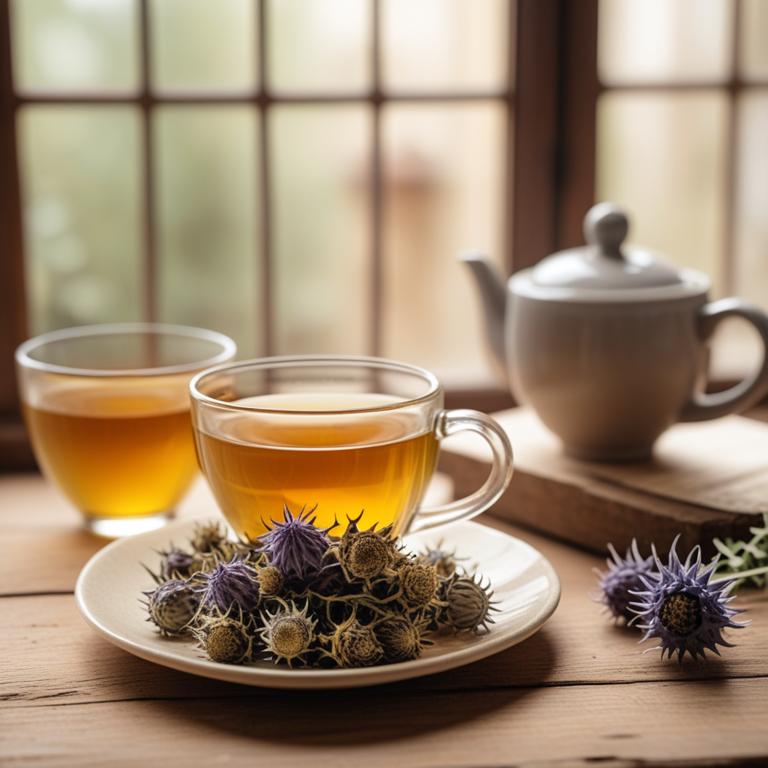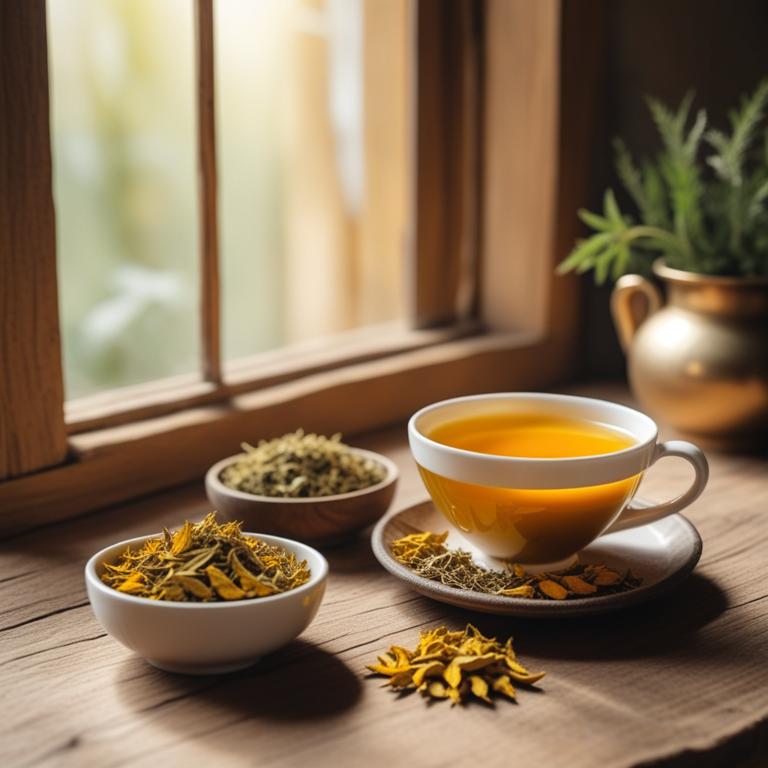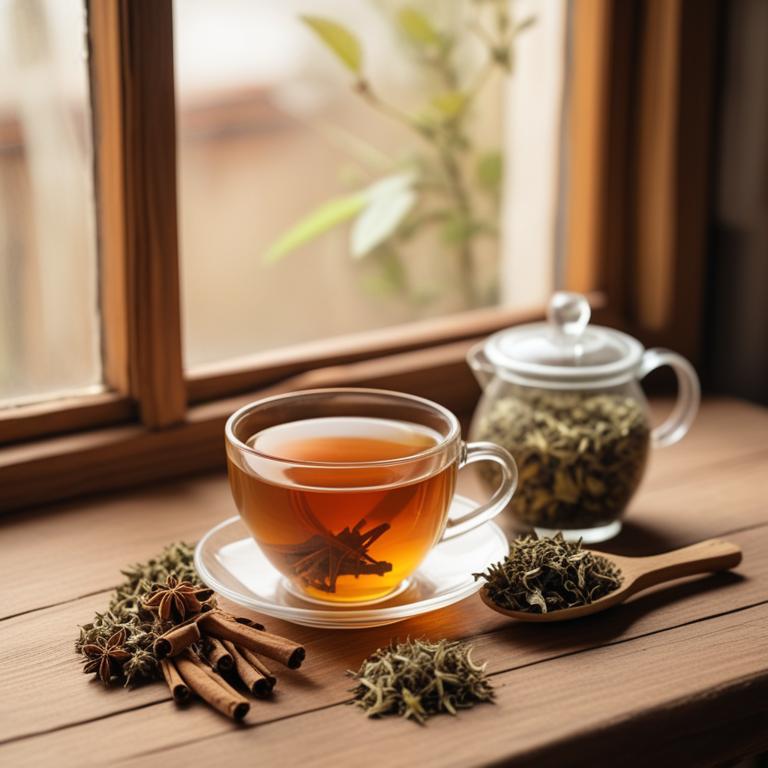7 Herbal Teas For Painful Swallowing

When you're struggling with painful swallowing, it can be a real challenge to get through your day.
But did you know that herbal teas can offer some relief?. These teas work by reducing inflammation and soothing the throat, which can help ease the discomfort. For example, Ginger (Zingiber officinale) is a natural anti-inflammatory that can help calm the throat and reduce pain. Licorice root (Glycyrrhiza glabra) has anti-inflammatory properties that can help soothe the mucous membranes in your throat, making it a great option for painful swallowing.
Another herb that's often used to help with inflammation and boost the immune system is Echinacea (Echinacea purpurea), which can help your body fight off underlying infections that may be causing the pain. Herbal teas can make a big difference in your life when you're dealing with painful swallowing. By reducing inflammation and soothing the throat, these teas can help you feel more comfortable and able to eat and drink without pain. This can be especially helpful if you're experiencing chronic pain or discomfort in your throat, as it can make everyday activities feel less daunting. Drinking herbal teas can also give you a sense of control over your symptoms, which can be really empowering.
Plus, many of these herbs have other health benefits, such as aiding digestion or reducing stress, so you can enjoy the benefits beyond just relieving painful swallowing.
- 1. Zingiber officinale
- 2. Glycyrrhiza glabra
- 3. Echinacea purpurea
- 4. Curcuma longa
- 5. Ginkgo biloba
- 6. Cinchona officinalis
- 7. Silybum marianum
1. Zingiber officinale

Zingiber officinale teas contains gingerols and shogaols, bioactive compounds that give it pain-relieving properties.
These compounds work by blocking the production of a chemical called bradykinin, which can cause pain and inflammation in the throat. When you have painful swallowing, the muscles in your throat are tense and sore, but the anti-inflammatory properties in gingerols and shogaols help to reduce swelling and ease discomfort. The warming sensation of ginger also helps to relax the muscles in your throat, making it easier to swallow.
By reducing pain and inflammation, Zingiber officinale teas can provide relief from painful swallowing.
- Gather 1 cup of fresh Zingiber officinale (ginger) roots, a tablespoon of honey, and a cup of boiling water.
- Wash the ginger roots, then chop them into small pieces.
- In a cup, combine the chopped ginger and boiling water. Let it steep for 5-7 minutes.
- Strain the ginger tea into another cup. Add a tablespoon of honey to taste.
- Drink the ginger tea warm, 2-3 times a day, to help soothe painful swallowing.
Zingiber Officinale Tea on Amazon
FGO Organic Ginger Tea, 100 Count, Eco-Conscious Tea Bags, Caffeine Free, Packaging May Vary (Pack of 1)
Disclaimer: We earn a commission if you click this link and make a purchase at no additional cost to you.
2. Glycyrrhiza glabra

Glycyrrhiza glabra teas contains the bioactive constituents glycyrrhizin and flavonoids, which have anti-inflammatory and soothing properties.
These properties help to reduce swelling and irritation in the throat, making it easier to swallow. Glycyrrhizin, in particular, has been shown to inhibit the production of pro-inflammatory enzymes, which can contribute to painful swallowing. The flavonoids in Glycyrrhiza glabra tea also have antioxidant properties, which can help to protect the mucous membranes in the throat from damage.
By reducing inflammation and protecting the mucous membranes, Glycyrrhiza glabra tea can help to alleviate painful swallowing and promote a sense of comfort and relief.
- Gather 1 teaspoon of dried Glycyrrhiza glabra root, 1 cup of water, and a tea infuser.
- Boil the water in a kettle or on the stove.
- Place the dried root in the tea infuser and steep it in the boiling water for 5-7 minutes.
- Strain the tea into a cup and discard the root. You can add honey to taste.
- Drink the tea 2-3 times a day, ideally after meals, to help with painful swallowing.
3. Echinacea purpurea

Echinacea purpurea teas contains active constituents like alkylamides, caffeic acid, and flavonoids.
These compounds have anti-inflammatory properties, which can help reduce swelling and pain associated with painful swallowing. Alkylamides, in particular, have been shown to inhibit the production of pro-inflammatory chemicals, which can contribute to swelling and discomfort. Caffeic acid and flavonoids have antioxidant properties, which can help protect the mucous membranes in the throat from damage and promote healing.
By reducing inflammation and promoting healing, Echinacea purpurea teas may help alleviate painful swallowing symptoms.
- Gather 2 teaspoons of dried Echinacea purpurea flowers and a cup of boiling water.
- Pour the boiling water over the dried Echinacea flowers in a cup.
- Let the mixture steep for 5-7 minutes, then strain it into another cup.
- Add honey to taste, if needed, and stir well.
- Drink the tea 2-3 times a day for relief from painful swallowing.
4. Curcuma longa

Curcuma longa teas contains the bioactive constituents curcumin, demethoxycurcumin, and bisdemethoxycurcumin.
Curcumin has anti-inflammatory properties that can help reduce swelling in the throat and esophagus, making it easier to swallow. Turmeric's active compound also has antioxidant properties that can protect the mucous membranes from damage and promote healing. The anti-inflammatory and antioxidant effects of Curcuma longa teas help to alleviate painful swallowing by reducing inflammation and promoting the health of the mucous membranes.
Curcuma longa teas' properties can help to alleviate painful swallowing by reducing inflammation and promoting healing in the affected area.
- Get 1 teaspoon of dried Curcuma longa root powder and 1 cup of boiling water.
- Add the powder to the boiling water and stir well.
- Reduce the heat to low and let it simmer for 5-7 minutes.
- Strain the mixture into a cup and let it cool.
- Drink the tea 2-3 times a day for relief from painful swallowing.
5. Ginkgo biloba

Ginkgo biloba teas contains active constituents like flavonoids and terpenoids.
These compounds have anti-inflammatory properties that help reduce swelling and irritation in the throat. The flavonoids, particularly quercetin, have antioxidant properties that protect the mucous membranes from damage and promote healing. Ginkgo biloba's terpenoids also have a natural anti-inflammatory effect that can help ease pain and discomfort associated with painful swallowing.
By reducing inflammation and promoting healing, Ginkgo biloba teas may provide relief from painful swallowing.
- Gather 1 cup of boiling water and 1 teaspoon of dried Ginkgo biloba leaves.
- Measure 1 teaspoon of dried Ginkgo biloba leaves and place them in a tea infuser.
- Steep the Ginkgo biloba leaves in the boiling water for 5-7 minutes.
- Strain the tea into a cup and discard the Ginkgo biloba leaves.
- Drink 1 cup of Ginkgo biloba tea, 2-3 times a day, for relief from painful swallowing.
6. Cinchona officinalis

Cinchona officinalis teas contains alkaloids such as quinine and cinchonine, which have anti-inflammatory and analgesic properties.
These compounds work together to reduce swelling and ease pain associated with painful swallowing. The anti-inflammatory properties of cinchonine and quinine help to decrease inflammation in the throat, while their analgesic properties numb the pain. Additionally, the alkaloids in Cinchona officinalis teas have a mild antiseptic effect, which helps to prevent infections that can cause painful swallowing.
By reducing inflammation, numbing pain, and preventing infections, the alkaloids in Cinchona officinalis teas can help to alleviate painful swallowing.
- Gather 1 cup of boiling water, 1 teaspoon of dried Cinchona officinalis bark, and a cup.
- Measure 1 teaspoon of dried Cinchona officinalis bark and add it to the cup.
- Pour 1 cup of boiling water over the dried Cinchona officinalis bark in the cup.
- Steep for 5-10 minutes, then strain the mixture into another cup.
- Drink the tea slowly and carefully, as it may be too hot.
7. Silybum marianum

Silybum marianum teas contains flavonoids, such as silymarin, which has antioxidant properties that help reduce inflammation in the throat.
Silymarin also has anti-inflammatory properties that soothe and calm the mucous membranes, making it easier to swallow. The sesquiterpenes and flavonoids in Silybum marianum teas have a protective effect on the mucous membranes, preventing damage and irritation that can cause painful swallowing. The anti-inflammatory and antioxidant properties of Silybum marianum teas work together to reduce swelling and discomfort in the throat, making it a potential remedy for painful swallowing.
By reducing inflammation and soothing the mucous membranes, Silybum marianum teas may help alleviate painful swallowing and promote a smooth, comfortable swallowing experience.
- Gather 1 cup of fresh or dried Silybum marianum flowers and leaves. Clean and dry them.
- Measure 1 tablespoon of the flowers and leaves. Place them in a heat-resistant cup or mug.
- Pour 1 cup of boiling water over the Silybum marianum. Let it steep for 5-10 minutes.
- Strain the tea into another cup using a fine-mesh sieve or cheesecloth. Discard the solids.
- Drink the tea warm or at room temperature. Repeat as needed for painful swallowing.